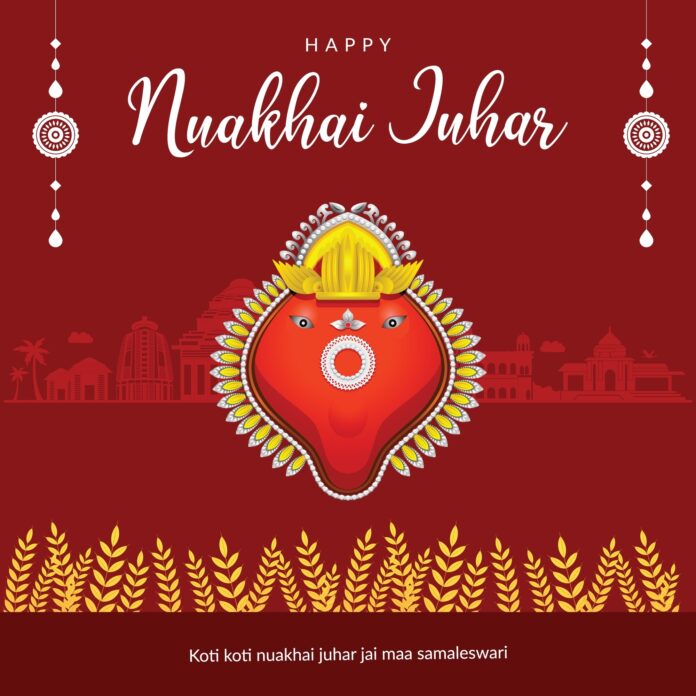Table of Contents
ToggleNuakhai Festival 2024
Nuakhai is one of the most significant agrarian festivals celebrated in the western part of Odisha and some parts of Chhattisgarh. It marks the beginning of the harvest season and is a day dedicated to giving thanks to the divine forces for a successful crop yield. In 2024, this vibrant festival will continue to be a celebration of community, tradition, and agricultural abundance. Let’s explore everything about Nuakhai Festival 2024, from its date and history to how it is celebrated.
Also Read: Samvatsari Festival 2024: Date, History, Why We Celebrate
Nuakhai Festival 2024 Date
The Nuakhai festival is observed on the day after Ganesh Chaturthi, which falls in August or September, depending on the lunar calendar. In 2024, Nuakhai will be celebrated on September 08, 2024. The exact date of the festival is determined based on the traditional Hindu calendar, and each family observes the festival at a specific time, which is usually decided by the village priest.
History of Nuakhai Festival
The history of Nuakhai is rooted in the agrarian culture of Odisha. The term “Nuakhai” literally translates to “nua” (new) and “khai” (to eat), symbolizing the consumption of the season’s first harvest. The festival dates back several centuries and is believed to have been celebrated since ancient times when agriculture was the primary occupation of the people in this region.
- Historical Origins: The origin of Nuakhai is linked to the ancient farming practices in Odisha, where people would celebrate the arrival of the new crop by offering the first produce to the local deities. It was also a way to ensure communal harmony and peace, as the entire village would come together to celebrate.
- Role of the Chauvan Dynasty: During the reign of the Chauvan rulers in the 12th century, Nuakhai was formalized as a festival of great significance. The rulers themselves took part in the celebrations, making it a royal event as well as a local festival.
- Spread to Other Regions: While Nuakhai is most prominently celebrated in western Odisha, the festival has also spread to parts of Chhattisgarh and Jharkhand, particularly in areas with a significant Odia-speaking population.
Significance of Nuakhai Festival
Nuakhai holds immense cultural, social, and religious significance. For the people of Odisha, it is more than just a harvest festival; it is a time to bond with family and community, seek the blessings of the elders, and offer thanks for the bounty of nature.
- Agricultural Significance: Since Odisha is primarily an agricultural state, Nuakhai is a festival that celebrates the first yield of the paddy crop, which is the staple food of the region. The festival is a way of expressing gratitude to the Earth and deities for a successful harvest.
- Cultural Significance: Nuakhai is an opportunity for families and communities to come together. It strengthens social bonds as people from different strata of society participate in the celebrations, exchange gifts, and prepare traditional foods.
- Religious Significance: The festival also has a strong religious aspect. People offer the first grains of their harvest to the local deity, seeking divine blessings for prosperity, good health, and peace.
How to Celebrate Nuakhai Festival
Nuakhai is a vibrant and elaborate festival that is celebrated with enthusiasm across western Odisha. Although the festival’s customs and rituals may vary slightly between regions, the core spirit of thanksgiving and community remains the same.
1. Preparation for Nuakhai
The preparations for Nuakhai begin days before the actual festival, with homes being cleaned and decorated. The preparation phase is also marked by the making of traditional sweets and snacks, and families planning their rituals together.
- Cleaning and Decoration: In most households, family members clean and decorate their homes in the days leading up to Nuakhai. People decorate their homes with rangoli designs, flowers, and new clothes.
- Preparation of Traditional Foods: The preparation of traditional dishes is an essential part of the festival. Dishes like “Arisa Pitha” (a type of rice cake), “Manda Pitha,” and “Kheeri” (rice pudding) are popular delicacies made during Nuakhai.
2. Offering the First Harvest to the Deity (Nuakhai Juhar)
On the day of Nuakhai, the first grain of the newly harvested crop is offered to the local deity, followed by family members. This ritual is known as Nuakhai Juhar and is considered one of the most important parts of the celebration.
- Offering to the Deity: The priest or the head of the family performs the Puja (worship), offering the first grains of rice and fresh fruits to the local deities. In many villages, people visit the temple of the village deity to make their offerings.
- Family Rituals: After the offerings to the deity, family members share the new crop among themselves, beginning with the eldest member. The act symbolizes unity, respect for tradition, and the bond between the old and new generations.
3. Family and Community Bonding
Nuakhai is as much about family and community as it is about rituals. People visit their elders to seek blessings, exchange gifts, and partake in feasts with neighbors and relatives.
- Seeking Elders’ Blessings: It is a tradition for younger family members to visit their elders and seek their blessings on this auspicious day. Elders give their best wishes for a prosperous and healthy year ahead.
- Feasting and Sharing: After the rituals, families gather for a grand feast. Traditional dishes are prepared using the new harvest, and everyone eats together in a celebratory mood. Sharing food with friends, neighbors, and the less fortunate is also part of the custom.
4. Cultural Programs and Folk Performances
Nuakhai is also known for its cultural vibrancy. Various folk performances, music, and dance forms are integral to the celebration, reflecting the rich heritage of Odisha.
- Folk Dances and Songs: Traditional folk dances such as the Sambalpuri dance and music are performed in many villages. The lively rhythm and vibrant costumes make these performances a delight to watch.
- Nuakhai Bhetghat: The community celebration, known as Nuakhai Bhetghat, includes large gatherings where people exchange greetings, dance, sing, and take part in cultural programs organized in various parts of the region.
5. Modern-Day Celebrations
While Nuakhai continues to be celebrated with traditional fervor in rural areas, urban celebrations have evolved over time. Today, social media plays a significant role in bringing people together, with many Odia people living outside the state connecting online to celebrate.
- Virtual Celebrations: With increasing urbanization, many people who live away from their hometowns join virtual celebrations through video calls and social media posts. Virtual Nuakhai greetings and celebrations have become quite common, especially among the younger generation.
- Nuakhai in Cities: In major cities like Bhubaneswar, Sambalpur, and Rourkela, large-scale events are organized where people gather to celebrate Nuakhai together. These events include cultural performances, feasts, and the observance of traditional rituals.
Traditional Foods of Nuakhai
Food plays a central role in Nuakhai celebrations. The dishes prepared during the festival are made from the freshly harvested produce and reflect the rich culinary heritage of Odisha.
- Arisa Pitha: A type of rice cake that is deep-fried and sweetened with jaggery. It is a must-have delicacy during the festival.
- Manda Pitha: A steamed dumpling made of rice flour filled with sweet stuffing, usually coconut and jaggery.
- Kheeri (Rice Pudding): Made from the new harvest of rice, milk, and sugar, this dish is a traditional favorite during the festival.
- Chitau Pitha: A soft and spongy pancake made from rice flour, usually served with a side of jaggery syrup or fresh coconut chutney.
Nuakhai Celebrations Outside Odisha
With the migration of people from Odisha to other parts of India and abroad, Nuakhai is now celebrated in cities like Delhi, Mumbai, and even abroad, where there is a significant Odia population.
- Nuakhai Celebrations in Urban Areas: Odia communities in cities often organize large gatherings where people come together to celebrate Nuakhai with traditional food, music, and dance performances.
- Global Celebrations: With many Odias living abroad, the festival is also celebrated in countries like the USA, UK, UAE, and Australia, bringing the essence of Odisha’s culture to the global stage.
How To Reach Odisha
To reach Odisha, you can choose from various transportation options depending on your starting location. Here are some common ways to reach Odisha:
By Air: The state has several domestic airports, including Bhubaneswar Airport (BBI) and Jharsuguda Airport (JRG), which are well-connected to major cities like Delhi, Mumbai, Kolkata, and Bengaluru.
By Train: Odisha has an extensive railway network, and major cities like Bhubaneswar, Cuttack, Puri, and Sambalpur are well-connected to other parts of the country by train. You can check train schedules and book tickets online through the Indian Railways website or app.
By Road: Odisha is well-connected by road, and you can reach the state via national highways and state highways. The state-run Odisha State Road Transport Corporation (OSRTC) operates buses to various cities and towns within Odisha, as well as interstate services. You can easily book bus tickets on AbhiBus and have a hassle free journey. Here are some of the top bus routes of OSRTC
- Berhampur (Orissa) to Bhubaneswar Bus
- Bhubaneswar to Puri Bus
- Jeypore (Orissa) to Berhampur Bus
- Nayagarh (Odisha) to Bhubaneswar Bus
Conclusion
Nuakhai is not just a festival; it is a reflection of Odisha’s rich cultural heritage, communal harmony, and deep-rooted agrarian traditions. Celebrated with rituals, food, music, and dance, it brings families and communities together to give thanks for the blessings of nature. As we look forward to Nuakhai Festival 2024, let us embrace the spirit of gratitude, togetherness, and the joyous celebrations that make this festival a unique and integral part of Odisha’s identity.





